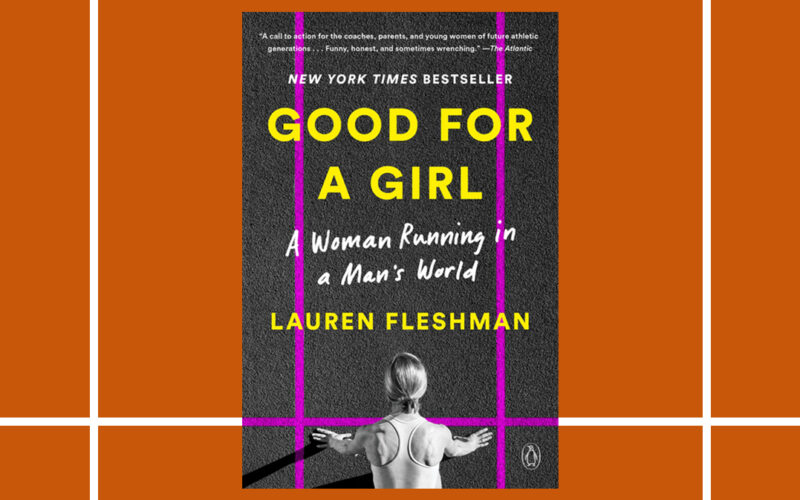“There is something wrong with our sports systems, and deep down we know it. The sports environments we fought so hard to have equal access to were built by men, for men and boys. Our definition of gender equality has been ‘getting what men have, and the way they have it,’ and it’s backfiring” (Fleshman XII).
In 1972, Congress passed Title IX, which legally protected female athletes against discrimination. As a result, the number of women competing in sports rose exponentially over the next fifty years. But is the way sports are structured biased against the female body? Are competitive sports enhancing or hurting women’s overall health? And has women’s inclusion in sports truly been an example of healthy feminism? In her new memoir, Good for a Girl: A Woman Running in a Man’s World, elite runner and coach Lauren Fleshman asks these pointed, pertinent questions and more, and provides powerful experiential and empirical evidence to back up her answers. Read to the end of our Good for a Girl book review to see whether we cast our vote for buying, borrowing, or passing.
The 42 year-old Fleshman has devoted the past twenty-seven years of her life to the competitive female sports arena, and has raced with the top female distance runners in America. Now retired from her competitive running career, Fleshman coaches elite female athletes, represents women’s fitness as a brand strategy advisor for the fitness apparel company, Oiselle, and runs her own natural food company, Picky Bars. Fleshman’s life is dedicated to transforming the female sports industry by supporting women to recognize the power and gift of their feminine design.
Who is the intended audience of Good for a Girl?
Good for a Girl is written primarily for female athletes and coaches in general, not just runners. The prevailing message throughout the book is that female athletes need to utilize the cyclical nature of their bodies (instead of ignoring or suppressing it), and coaches need to train female athletes differently than male athletes. Parents of female athletes, teachers, and medical professionals could all enjoy Fleshman’s memoir and gain insight into how to better advocate for women’s health and well-being.
What are the main content areas of Good for a Girl?
Broken up into 16 chapters plus an introduction, Good for a Girl is an engaging sprint through Fleshman’s running career. Beginning with her earliest running memories in elementary school, the book gives readers a sense of how Fleshman began to define herself by her athletic abilities. As she recounts her competitive college running days, Fleshman breaks down the unhealthy habits and mindsets she discovered in the female running community. Finally, Fleshman describes her transition from running for Nike to representing the athletic brand, Oiselle, and becoming a running coach.
Through each phase of her athletic career, Fleshman gives examples of stigma against and objectification of female athletes, their chronic eating disorder problems, and the pervasiveness of RED-S (relative energy deficiency in sport). Each part of her memoir is intended to encourage the reader to support a transformation in the female sports industry, one that will inspire women to honor and utilize their bodies based on their feminine design, rather than trying to become more masculine for the sake of someone else’s expectations or for a competitive edge.
Strengths of Good for a Girl
Fleshman’s passion for reconstructing the female sports industry reverberates through every line of Good for a Girl. She dives deep into the female psyche, sharing vulnerably about how her relationship with her alcoholic father drove her unhealthy mindset around running. Many female athletes, whether they compete at the high school or the elite level, will no doubt read something of their own story amidst the pages of this memoir.
As a former long-distance athlete myself, I was shocked to find that my “unexplainable” running injuries were a commonality in the female sports world. Fleshman’s repetitive mention of the relationship between hormonal health and injury prevention for female athletes served to confirm what I had merely suspected: my training, Fleshman’s training, and the training of the vast majority of female athletes does not serve us. It only furthers the dysfunctional mentality that women are only as good as their ability to compete with men, or as Fleshman so cleverly titled the book, “good for a girl”.
Limitations or blindspots
Overall, Fleshman’s memoir was written with a detailed, well-rounded message: female sports need to be re-created. Women should not have to succumb to male-minded linear training programs, be pressured to under-eat, or be physically objectified for the sake of publicity or sponsorships.
I wish she had included more about her current coaching career and how she is specifically making a difference in the lives of her female athletes. For example, including specific ways she tailors her training programs toward respecting female athletes’ cycles (also known as cycle syncing), would help readers know what concrete steps to take to make a difference themselves.
Because Fleshman frequently mentions the loss of healthy cycles in female athletes, it also would have been appropriate to include information on hormonal birth control use and how that also hurts female athletes’ health.
Every woman, whether she is an athlete or not, can benefit from reading Good for a Girl. Fleshman dives into tough topics such as eating disorders, allergies and food sensitivities, sexual objectification, body image issues, motherhood in the professional world, and hormonal disorders leading to chronic injuries.
Reading this book inspired me to share about healthy exercise habits with my friends who have children in sports. It reignited my passion for helping women understand the value of charting their cycles and seeking answers for hormonal abnormalities.
I have found myself reflecting on my past competitive running days and how the way I was coached affected my mental and physical well-being. Anyone who picks up this book will walk away just a little more knowledgeable on how to support women in caring for their bodies.
The verdict: To buy, borrow, or skip Good for a Girl altogether?
This gets a “buy” recommendation from me. While reading Good for a Girl for this book review, I found myself sharing what I read with doctors, friends, and even strangers in waiting rooms. Fleshman’s vulnerability and knowledge have the potential to prevent women athletes from giving up their dreams due to discouragement or avoidable injuries. My hope is that every female athlete, athlete parent, doctor who cares for young women, and coach would buy Good for a Girl and use Fleshman’s story and experiences to make a difference in the lives of female athletes.
Additional Reading:
Cycle syncing: How to hack the natural hormonal shifts of your menstrual cycle











